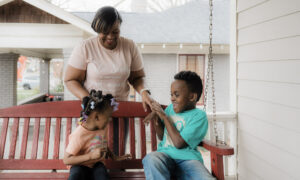2023 SHED Report: The SaverLife Reaction
Recently, the Federal Reserve released its annual report from the Survey of Household Economics and Decisionmaking (SHED) and the top-line takeaways are clear: Most US households are doing okay financially, however; they’re concerned about inflation, high housing costs, and a lack of savings. But are these the same takeaways for SaverLife members?
We compared SaverLife data against the latest SHED report to learn more. What we uncovered is that SaverLife members, and those living on low-to-moderate incomes, regularly face greater financial challenges — especially in relation to climate change and housing affordability.
Read on to learn more about our findings on SaverLife members’ financial health and how they compare to the average US household.
SaverLife members are taking more hits to their financial health

After aligning SaverLife data with SHED questions related to overall financial health, we learned that, while the SHED data identifies 72% of survey participants as “doing okay financially,” only 44% of our members feel the same. In fact, for all five SHED indicators, SaverLife members reveal lower levels of financial health compared to US households.
Many of the challenges outlined in these indicators are interlinked. If a SaverLife member’s spending is higher than their income, it makes it very difficult for them to save and pay bills on time. Similarly, if a member’s income shifts on a monthly basis, they might not be able to set money aside for expenses without disrupting their already fluctuating budget.
Exposure to climate change can lead to greater financial hardships

SaverLife members are also dealing with greater material and financial hardships in the wake of a climate event than the average US household. Despite 19% of SHED participants sharing that they’ve been financially affected by a natural disaster, over half (51%) of SaverLife members feel the same. Equally unsettling is the fact that the percentage of SaverLife members who have experienced income loss from a natural disaster is five times the number of SHED recipients.
These differences between US households and SaverLife members are so stark that it’s clear our members are especially vulnerable to the impacts of climate change. Property loss, food shortages, and falling behind on bills and loan payments: these are all due to the increasing presence of climate-related events in their daily lives — and in more ways than we realize.
Housing is playing an outsized role in members’ financial stability
When comparing the average US household against SaverLife data, we discovered that the percentage of our members who are behind on rent or had a late or missed rent payment is double (41%) the SHED report’s findings (19%).

But even this percentage doesn’t provide the full context necessary to understand why SaverLife members are feeling the pinch of housing costs. Housing affordability is also compounded by necessary expenses like groceries, child care, or student loan debt: costs of living that often require SaverLife members to make trade-offs between their most pressing expenses. This also doesn’t account for additional situations associated with housing like,
- Living temporarily with family or friends
- Moving due to safety concerns or overcrowding
- Dealing with health and safety conditions in the home
Compounding housing expenses and living situations are leaving little wiggle room for SaverLife members to maintain financial stability and still improve their financial health.
An opportunity to paint the bigger picture of financial health
SaverLife members are facing strong economic headwinds while confronting threat multipliers like climate change. They’re taking action where they can to achieve their goals, but the fact remains that more can be done to support them on their financial health journeys.
By addressing the needs and priorities of people living on low-to-moderate incomes, and weighing them against national averages, we can paint the bigger picture of financial health and influence policy, product, and service changes for the better. We can also ensure that the financial system actively supports SaverLife members — and the millions like them — to achieve lasting financial health and well-being.
Get the latest SaverLife research delivered straight to your inbox. Sign up for our research newsletter now and never miss an update.
Written by Mathie Despard


